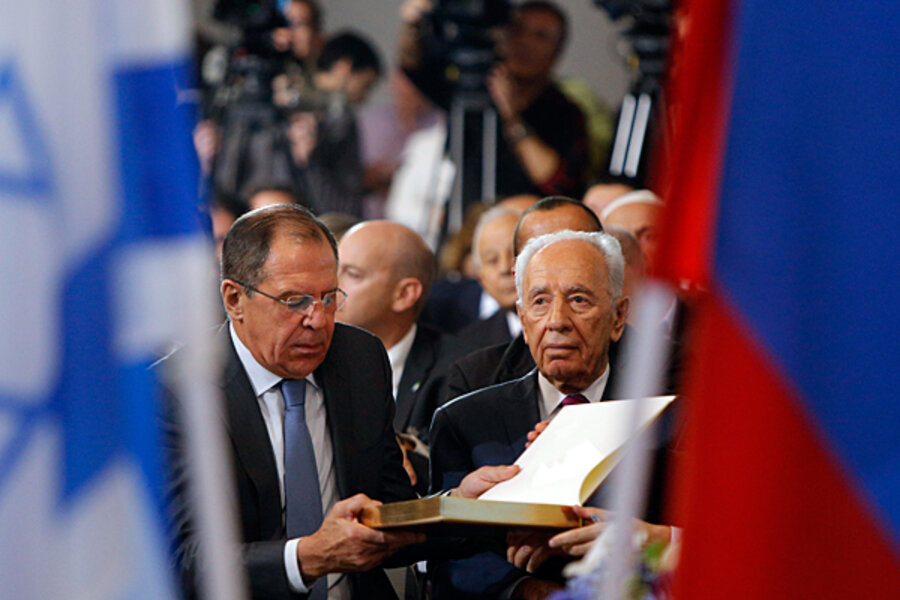In 'eloquent declaration,' Russia opens world's largest Jewish museum
Loading...
| Moscow
The world's largest museum of Jewish history opened in Moscow Thursday, marking an extraordinary turnaround for a community that once seemed to have almost vanished from Russia -- a country that was notorious for its official anti-Semitism until barely two decades ago.
The huge museum of Russian-Jewish history, which occupies a former Moscow bus depot, was opened by Belarus-born Israeli President Shimon Peres, who lauded it as a powerful symbol of how nations can change.
"At this emotional moment I can see generations of my people before my very eyes and I carry them with me," Mr. Peres said. "My parents were born in Russia. In my home we spoke Yiddish, Hebrew, and Russian....
"This museum is an eloquent declaration of the principles of tolerance toward people and their freedom. Here we can see man part with the past and move into the future with hope," he said.
The nearly 50,000 sq.-ft., $60-million center uses interactive media technologies, recreations of shtetl (small Jewish town) life, and 13 hours of videotaped personal testimony to tell the story of Russia's Jewish community. It focuses on the past 175 years, which saw Russian Jews move from the Czarist-era Pale of the Settlement (an area of Russia where Jews were allowed permanent residence) into mainstream Russian and Soviet society, face near extinction when the Nazis invaded the USSR, and later chafe for decades under official Soviet restrictions that kept them from many areas of higher education and important state jobs.
In the last three decades of the 20th century, more than 1 million Russian Jews voted with their feet by emigrating, leaving behind little of what was once the world's biggest Jewish community.
But over the past decade, large numbers have returned to Russia, mainly from Israel, to find a dramatically changed situation.
"For the Russian Jewish community to do this is really amazing," says head designer Ralph Appelbaum, whose company, Ralph Appelbaum Associates, is the world's largest museum exhibit design firm.
"But it's not a 'Jewish museum,' " he adds. "Rather, it's a museum of Russian history, told through the eyes of the Jews who stayed here – not those who left – and demonstrating the experience of this 'other' community in Russia..... The aim here is that all Russians schoolchildren should come here, experience it, and think about what it means to live in modern Russia."
Honest about anti-Semitism
Organizers say the museum pulls no punches about the impact of anti-Semitism in Russian and Soviet life, but also sheds light upon the immense contribution of Russia's Jews to the country's cultural and scientific life, and the solidarity among all Soviet citizens when faced with an existential crisis by the Nazi invasion after 1941.
The central purpose is to reintegrate Russian history, by exposing Russians to the experiences of people who lived among them, but were often persecuted.
"This is a different kind of museum, it's more about ideas than things," says Mr. Appelbaum. "Russia is famous for its museums, which hold vast collections full of marvelously preserved things. That's great, but this museum is just about the stories of people's lives."
One key difference from the past is that the Kremlin is no longer a forbidding obstacle to the revival of Jewish life in Russia, experts say.
President Vladimir Putin donated a month's salary toward the project and said, in a statement read out at the museum opening by Foreign Minister Sergei Lavrov, that he hopes the museum will be "a place for dialogue and agreement between peoples."
"This is a new era for the life of Russian Jews," Russia's chief Rabbi Berel Lazar, told the opening ceremony. "Many years for Jews were very hard and tragic. But now there are great changes."
Some experts warn that intolerance and ethnic hatreds are once again on the rise in Russia. Last weekend, thousands of Russian nationalists marched in downtown Moscow, shouting xenophobic slogans, such as "Russia For the Russians," which are aimed mainly at brown-skinned immigrants from Russia's south and former Soviet central Asian republics.
In a pre-election manifesto last winter, Mr. Putin warned that keeping nationalist energies under control is Russia's biggest single political challenge.
"Nationalist passions are growing in Russia, posing very serious problems for interethnic relations," says Alexander Brod, head of the independent Moscow Bureau for Human Rights. "We need more public education, and actions that help develop tolerance. This new museum can fill a critical gap. By outlining the tragic destiny of the Jewish people [in Russia] it can help people to think about issues like discrimination, genocide, and the value of human life. We may hope that it will make a difference."








